This was published 1 year ago
‘Frightening … reckless’: The companies selling extreme suntanning to young Aussies
A joint investigation by The Age, The Sydney Morning Herald and A Current Affair has uncovered the dangerous advertisements and dubious claims being used to promote a new generation of sun tanning products.
By Aisha Dow and Georgia Westgarth
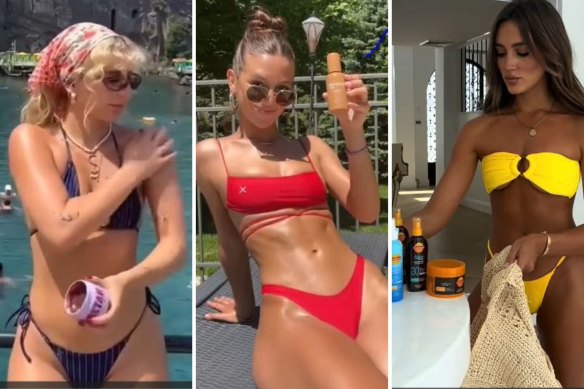
Still images from TikTok ads for Australian self-tanning products.Credit: TikTok
“How I look after two hours in the sun,” boasts an Instagram post from an Australian tanning oil company.
Alongside the message is a photograph of a young woman wearing a bikini, pulled aside to show off suntan lines so extreme it looks like her tan could be painted on.
The advertisement is from Brunae Body, one of several Australian companies spruiking a new brand of tanning oils, lotions and “accelerators” with claims that they can give a beautiful, “sun-kissed glow” or a “deeper, darker tan” with fewer downsides.
Results with “minimal time in the sun”. A tanning oil that can “nourish and hydrate” the skin. Ingredients that “help protect your skin from UV” and increase collagen.
These tanning accelerators are meant to work by encouraging melanin production, producing a darker-than-normal tan when skin is exposed to the sun.
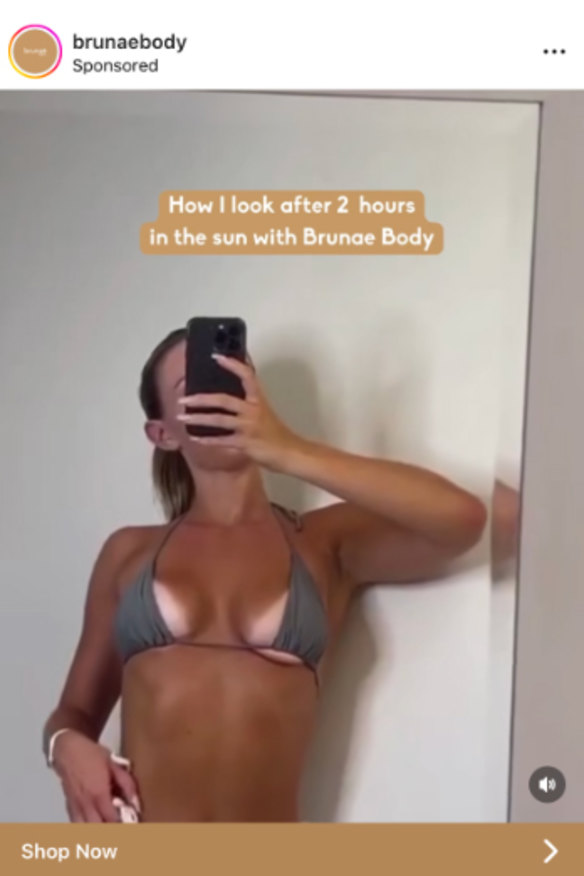
A sponsored social media post from tanning company Brunae Body.Credit: Meta
But cancer and skin experts – including melanoma treatment pioneer and newly anointed Australian of the Year Professor Georgina Long – are appalled. They have slammed the companies profiting from products that work by sending their customers out in the sun or into solariums, accelerating skin ageing and increasing users’ risk of skin cancer.
“This is terrible,” Long said, comparing the companies’ use of images of athletic young women lying in the sun in bikinis to the promotion of smoking.
“Someone is diagnosed with melanoma every 30 minutes and someone dies from melanoma every six hours in this country.”
A joint investigation by The Age, Sydney Morning Herald and A Current Affair has examined the claims and marketing tactics of four of the Australian companies spruiking suntanning accelerators to young women with reams of images that glamorise sun exposure.
While the companies’ websites and disclaimers talk of sun safety, their social media accounts often show flagrant disregard for sun-safe practices, celebrating extreme tan lines. Some have posted videos where influencers in swimsuits spend hours in the hot sun or seek out dangerous levels of UV.
The investigation also found that a Californian high school student has been promoting a tanning oil from one of the companies, Melbourne-based Brunae Body. She first appeared on the company’s TikTok account shortly after she celebrated her 16th birthday, according to other social media activity posted by the girl and her family and friends.
The teen has appeared on the company’s social media accounts at least two dozen times. Melanoma is the most commonly diagnosed cancer for Australians aged 15 to 24.
‘Reckless’ advertising
All the companies encourage their users to wear sunscreen while using their tanning products. But their advertising disregards many of the tenets of the iconic “Slip, Slop, Slap” campaign, which encourages Australians to slip on clothing, slop on sunscreen, slap on a hat – and now to also seek shade and slide on sunglasses.
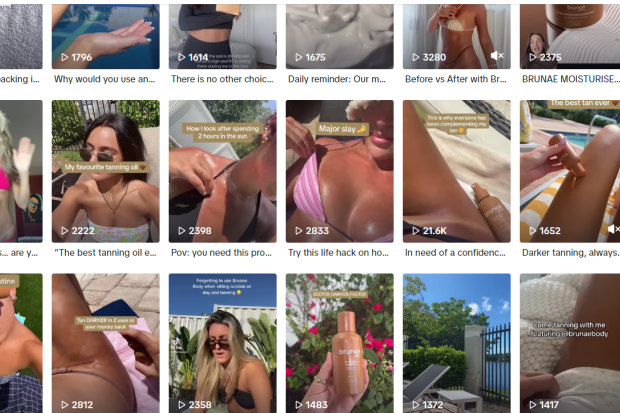
Brunae Body’s TikTok account.Credit: TikTok
These companies’ social media accounts are instead flooded with images and videos of hatless women lying in the direct sun in small bikinis, flaunting dark tans. Some people commenting on a Brunae Body TikTok video observed the tanning was so extreme it was like the model had changed race.
Meanwhile, several videos show tanning results after multiple hours in the sun.
A sponsored Instagram post by The Fox Tan has an image of a prominent tan line around a woman’s bikini and is captioned: “This was just three hours in the sun.”
Dr Adriene Lee, president of the Australasian College of Dermatologists, said it was frightening that such dangerous practices were being promoted to young people. Depending on the time of day and location, she said it could take as little as 10 minutes for UV to start being absorbed into skin cells, triggering DNA changes that can predispose people to skin cancer and cause premature ageing as well as other skin damage.
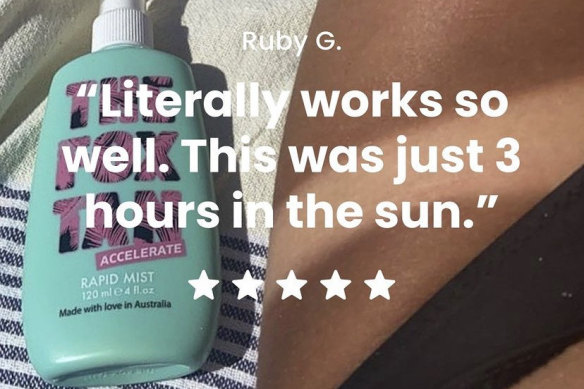
A sponsored social media advertisement from The Fox Tan.Credit: Meta
A TikTok video from Carroten Australia shows a woman heading out to lie on a pool chair when the “the UV is 10”, a level considered very high and bordering on extreme by the Cancer Council. On a clear summer day in Melbourne and Sydney, the UV index averages 10 and 11 when the sun is at its highest, according to the Bureau of Meteorology.
The Carroten Australia video apparently contradicts the company’s own advice, published on its website, that says people should avoid exposure to the sun during “midday hours” of 11am to 4pm.
Lee dubbed the video, and another like it from Carroten, as irresponsible and reckless.
“Once the UV gets [to] three and above, it actually starts to cause damage and changes in your skin, so the higher the UV index, the more intense the damage is, and the faster it happens.”
Further raising the hackles of sun-smart advocates, three of the four companies say that their tanning oils and accelerators can be used in solariums or sunbeds. One of the companies, The Fox Tan, has a product specifically designed for sunbed use.
Commercial use of solariums is banned in most Australian states and territories as they markedly increase users’ risk of skin cancer.
Not only does The Fox Tan advise their customers that their products are effective in sunbeds, they also say they should use them multiple times for the product to work best.
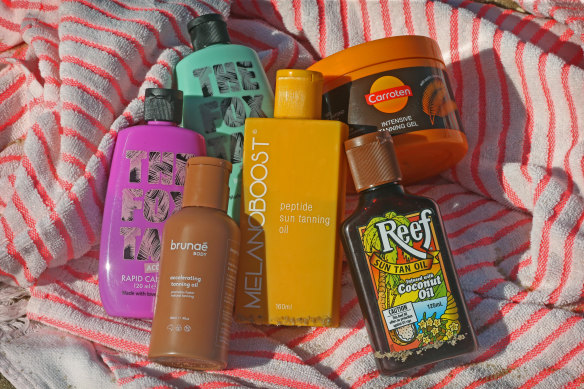
These tanning oils continue to be used by young Australians.Credit: Rebecca Hallas
“Given they are short bursts of UV, the more sessions, the better the results”, says information on the frequently asked question section of the company’s website.
Emma Glassenbury, the head of SunSmart, said solarium use before the age of 35 could lead to an almost 60 per cent greater risk of melanoma.
“Solariums can admit levels of UV radiation up to three times as strong as the summer midday sun, so this intense UV exposure can lead to sunburn and DNA damage in a matter of minutes.”
How do the tan accelerators work?
Two cosmetic chemists examined the products’ ingredients and marketing claims, explaining that three of the companies used an amino acid called tyrosine, or chemically modified versions of it called acetyl tyrosine and oleoyl tyrosine.
Terri Jones, an experienced cosmetic chemist and founder of Australian skincare company Synergie Skin, explained that the amino acid could help accelerate melanin production, the substance in the human body that causes skin pigmentation. She said the premise appeared to be that by giving the body the extra raw material it needed, it could make more melanin in the sun.
However, while The Fox Tan and Carroten Australia use a chemically modified version of tyrosine, which may be better absorbed by the body, the version listed in the ingredients of the Brunae Body tanning oil doesn’t appear to be modified.
Because of this, Dr Michelle Wong, a cosmetic chemist and science educator, believes it’s unlikely that the tyrosine in the Brunae Body product would work as well to increase melanin production. Instead, she said it probably worked like an “old-school tanning oil”.
Its top ingredients are almond oil, grape seed oil, olive oil, cotton seed oil, sunflower seed oil, jojoba seed oil, mango seed butter and coconut oil.
“I think the way that it mostly works is actually just by increasing UV’s [penetration] into [the] skin … If you’re in the sun for two hours, then you get more UV into your skin, which does accelerate the tan I guess, but it’s also increasing skin damage by a lot.”
Jones said when she looked at the limited data available on the performance of these types of products, it showed that while some people responded strongly to the tyrosine to produce melanin, others did not.
She is worried this could encourage young people to spend even longer in the sun chasing the type of tan they’ve seen on social media or that their friends managed to achieve using the same product.
“In none of these products do they [explain the exact] dose required to promote the tan, and that’s critical … people are going to be lulled into a false sense of security, and they’re going to say, ‘OK, well, there is no recommended dose, I’m going to just do it for as long as I can until something happens’.
“That is just so dangerous in my opinion.”
A number of reviews for the Brunae Body accelerating oil reported that they had suffered sunburn despite using the oil with sunscreen. Another reviewer wrote that they had “sat in the sun for so long” during a holiday in Perth and got no darker.
In a blog post on Carroten Australia’s website, the company claims the orange pigment contained in carrots, called beta-carotene, is the “hero ingredient” of its tanning gel as it can “boost melanin production which ultimately gives our skin that instant and natural tanning result”.
However, this was debunked by Wong, who said there was no evidence that beta-carotene boosts melanin production.
We asked Carroten Australia about this claim. The company did not directly respond but instead sent a statement saying the brand, which also sells a range of sunscreens, was “committed to promoting healthy practices when it comes to sun safety” and encouraged “consumers to always apply the highest level of sun protection as part of any use of a tanning product”.
A fourth tanning accelerator product, Melanoboost, contained different chemically synthesised ingredients designed to induce melanin production, Jones said. She was concerned by claims from the company that its “unique combination of peptide actives” could “strengthen the skin’s natural photoprotection” in the lead-up to UV exposure.
“[This] really bothers me because it’s almost saying that it’s going to act as a sunscreen and there is no TGA [Therapeutic Goods Administration] approval with this product whatsoever.”
The TGA has vowed to review the products following inquiries from this masthead “to determine if any are presented as therapeutic goods and take appropriate regulatory action if required”.
Multiple requests for comment from Brunae Body and Melanoboost went unanswered this week. A representative for The Fox Tan said that the company’s “owners are currently out of office” on leave or travelling for business.
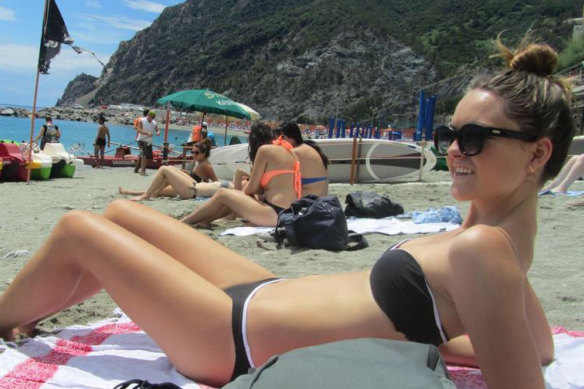
Kate Thomas, seen here on holiday in Italy, was shocked when a stage-one melanoma was removed from her leg in 2020. She used tanning oil as a teenager during frequent beach visits.
Wong said while it was possible that some of the tanning accelerators had ingredients that could give users a darker tan with lower rates of UV exposure, the products were untested compared to simply protecting the skin from the sun, or compared to fake tans.
She pointed out that a type of tanning accelerator used in the 1980s before being banned contained psoralen, since shown to be carcinogenic.
“These new accelerators seem to work differently and should present a lower risk, but because they’re cosmetics, there’s no extensive checking of safety data by regulators before sale. The old accelerator was banned in a lot of places after the safety risk became clear, but not before melanoma cases started developing,” she said.
“Spending time in the sun, without sun protection, is going to increase your risk of UV damage, which leads to skin cancer and accelerated skin ageing … I think you are risking long-term damage for potential short-term gains.”
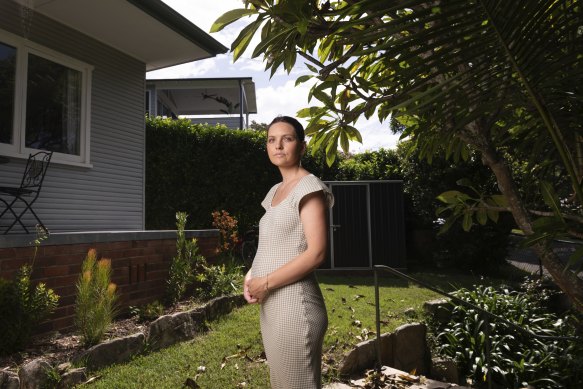
Kate Thomas can see why tanning oils appeal to young people, but says “it’s just so not worth it.”Credit: Rhett Wyman
‘Biggest wake-up call’
Sydney sales professional Kate Thomas has already experienced the dark side of tanning oil use, having developed melanoma in her 20s after years of chasing bronzed skin.
Thomas, now 31, said despite her parents’ pleas that she practise sun safety, as a teenager she would go out most weekends to the northern beaches with her friends, using Reef tanning oil to accelerate her tanning.
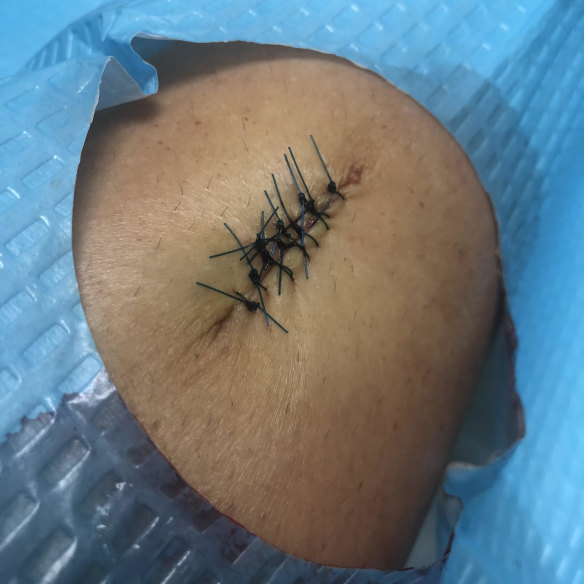
Stitches in Kate Thomas’ leg following the removal of a melanoma in 2020.
She said the tanning oil was considered a beach accessory that she was keen to be seen or photographed with.
“The bottle was really aesthetically pleasing,” she said. “I distinctly remember the coconut smell.”
In 2020, Thomas got the “biggest wake-up call” when she had a stage-one melanoma removed from her right leg, which she suspects is linked to her repeated sunburns and use of tanning oils, given she had no family history of the cancer.
Thomas believes the latest generation of tanning oils – with their social media images of thin and beautiful models – will appeal to teenagers, but she urged young people not to be seduced by these idealised depictions of tanning.
“It’s just so not worth it.”
The company behind Reef tanning oils recently decided to remove any reference to a “suntan” on its “hydrating oil” products that do not contain SPF sunscreen, a spokesperson said. The change will be implemented this year.
“For products which do not contain SPF, a caution is displayed prominently on the front of pack that the product contains no protection against UV rays, and the directions for use clearly advise that the product should be used in conjunction with a high protection sunscreen,” the spokesperson said.
Lee said that using sunscreen with a tanning oil would likely reduce the tanning effect, but also could give people a “very false sense of security” because sunscreen is only one aspect of sun protection – and also because not all sunscreens provide protection against UVA as well as UVB rays.
“It’s the UVA that penetrates deeper and also causes sun damage.”
Make the most of your health, relationships, fitness and nutrition with our Live Well newsletter. Get it in your inbox every Monday.